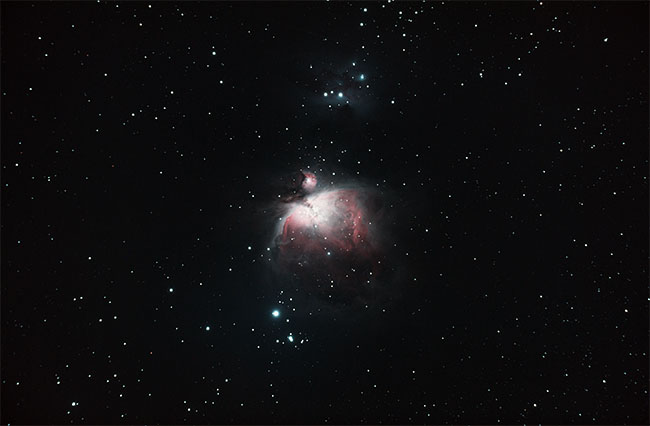M42 - Orion nebula
 For the third weekend in a row we went out after work on a friday to Ekerö. According to the weather forecast it looked like it was going to be OK this night, but as always the clouds started to roll in when we were almost at Ekerö. We decided to set up both telescopes (Meade 12" LX200 SCT and Meade 10" LX50 SCT) plus the astrotrac anyway in case the clouds would dissapear. Luckily it cleared up just as the sun had set so we were out with the telescope pretty much all night (until 4.30 AM). We had a lot of struggling with the equipment, as we for instance never managed to get the autoguiding work with the LX50. There were also problems with the autoguiding of the LX200, but just mostly probably due to the fact that we started with objects just above our heads. At 01.00 AM (after 5 hours of setting up and testing) we could finally start doing some imaging. During this I think I saw Neptune for the first time. The reason for saying "think" is because we looked at the right location and everything, but even despite that it still looked like a star! It is so tiny it was not possible to notice if it was a disk and therefore I can't be sure we actually saw Neptune. We think this image of the Orion nebula (and running man nebula, NGC 1977) is a lot better than our last attempt last winter.
For the third weekend in a row we went out after work on a friday to Ekerö. According to the weather forecast it looked like it was going to be OK this night, but as always the clouds started to roll in when we were almost at Ekerö. We decided to set up both telescopes (Meade 12" LX200 SCT and Meade 10" LX50 SCT) plus the astrotrac anyway in case the clouds would dissapear. Luckily it cleared up just as the sun had set so we were out with the telescope pretty much all night (until 4.30 AM). We had a lot of struggling with the equipment, as we for instance never managed to get the autoguiding work with the LX50. There were also problems with the autoguiding of the LX200, but just mostly probably due to the fact that we started with objects just above our heads. At 01.00 AM (after 5 hours of setting up and testing) we could finally start doing some imaging. During this I think I saw Neptune for the first time. The reason for saying "think" is because we looked at the right location and everything, but even despite that it still looked like a star! It is so tiny it was not possible to notice if it was a disk and therefore I can't be sure we actually saw Neptune. We think this image of the Orion nebula (and running man nebula, NGC 1977) is a lot better than our last attempt last winter. 
 A nebula is an interstellar cloud of dust, hydrogen, helium and ionized gases. Nebulae are often star-forming regions, in where the formations of gas, dust and other materials clump together to form larger masses, which attract further matter, and eventually will become massive enough to form stars. The remaining materials are then believed to form planets, and other planetary system objects.
A nebula is an interstellar cloud of dust, hydrogen, helium and ionized gases. Nebulae are often star-forming regions, in where the formations of gas, dust and other materials clump together to form larger masses, which attract further matter, and eventually will become massive enough to form stars. The remaining materials are then believed to form planets, and other planetary system objects. ― source and more information wikipedia
― source and more information wikipedia
Date: 2013-10-11
Location: Ekerö, Sweden
Temperature: 7 °C
Telescope: Skywatcher Equinox 80 APO
Camera: Canon 500D
ISO: 1600
Mount: Meade fork-mount
Exposure time: 47 X 45 sec
Reducer/flattener: William-Optics 0.8X reducer/flattener (P-FLAT-F6)
Filter: Astronomik CLS
Other info: Autoguided with 50mm scope and QHY5-II ontop of a Meade 12inch LX200 GPS.
Processing: Stacked and darks-subtracted in DeepSkyStacker. Processed in Photoshop CS6.




 2013-10-11
2013-10-11 